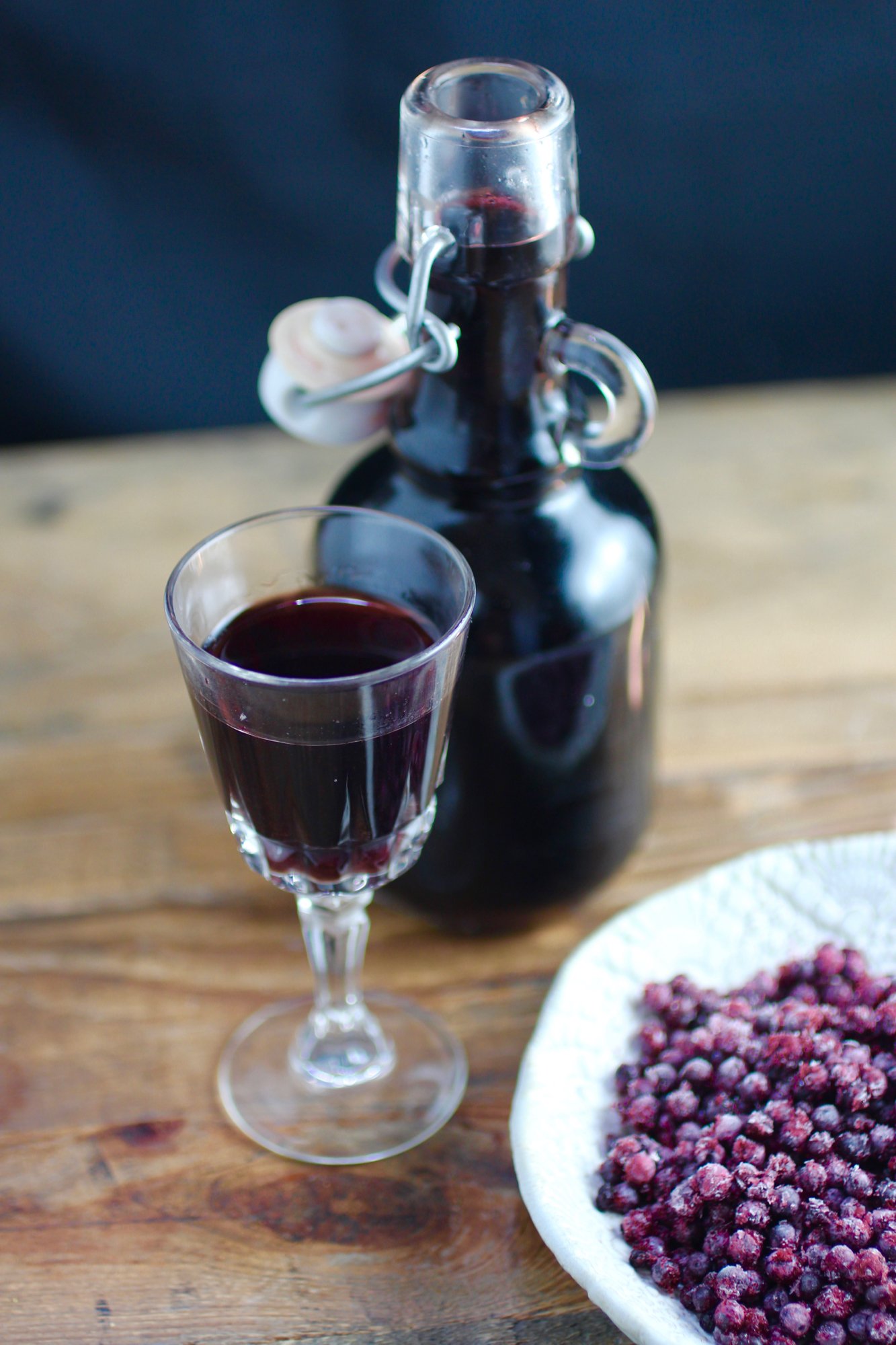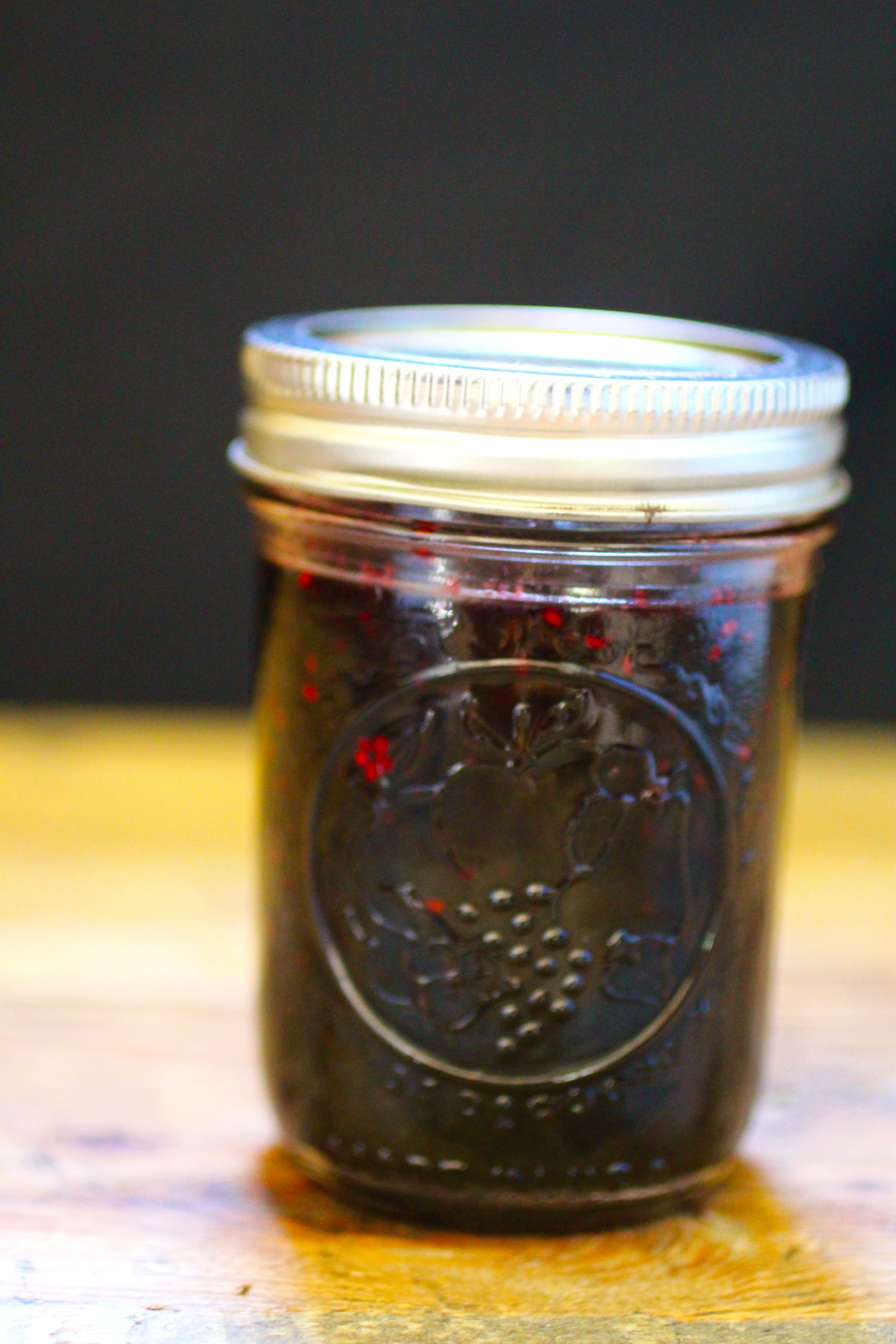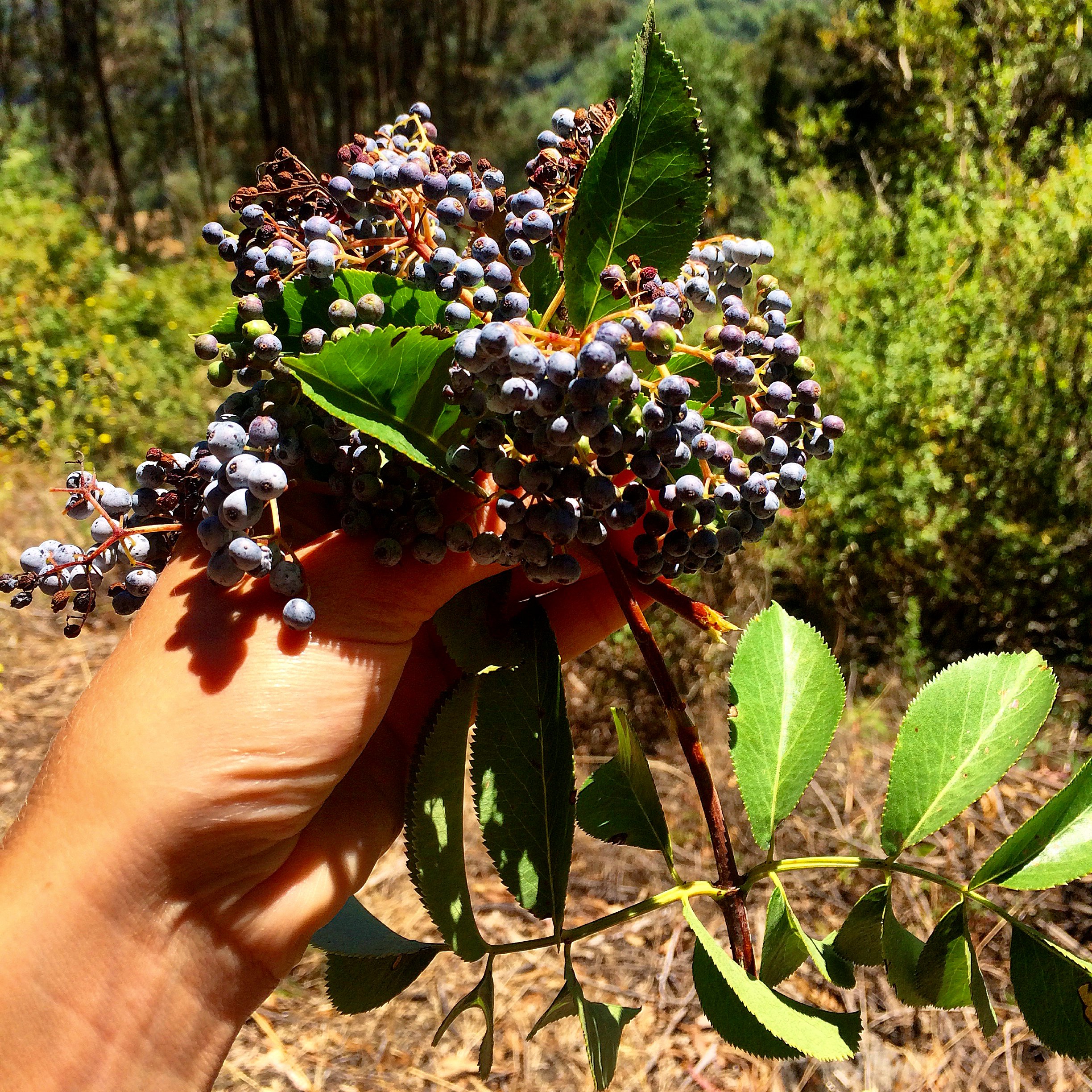Spiced elderberry cordial
Unlike elderflower cordial, elderberry cordial is a stronger, thicker syrup containing alcohol that is used in both medicinal and culinary applications. The syrup is sometimes taken regularly for cold and flu prevention (there is limited peer-reviewed, but much anecdotal evidence suggesting the berries enhance immune response), to top pancakes, or, as I particularly enjoy, with champagne for an “elderberry kir royale”. Feel free to experiment with the spice blend, add other ingredients such as citrus peel and herbs, or keep it simple with just the berries.
1 1/4 cups dried elderberries or 2 cups fresh
1 cinnamon stick, crushed
1 star anise
About 3 cups brandy
Honey, to taste (maple syrup or other sweetener can be substituted for honey)
Place elderberries, cinnamon, and star anise into a clean quart-sized glass jar. Add brandy to fill the jar and cover with a lid. Label the jar with contents and the date. Set aside in a cool, dark place for 3 to 4 weeks.
Strain cordial through cheesecloth over a large bowl. Squeeze contents of cheesecloth to release remaining liquid into the bowl then discard solids.
Add about 1/2 cup sweetener, such as honey, for every 1 cup liquid (or to taste). Stir to dissolve. Using a funnel, pour cordial into a clean bottle (or several clean bottles) and seal with cap or cork. A cordial using fresh
A cordial made with fresh elderberries will last about a year, whereas a cordial made with dried berries will last for 2-3 years and improve with age. Store in a cool, dark place and use as a cold and flu preventative, over desserts, or in beverages.
elderberry jam
More information on foraging and exploring elderberry here.
This recipe is a great way to quickly preserve the flavor of elderberries for later use on toast or in dessert applications. Makes 4 half-pint jars.
4 cups fresh elderberries
3 cups granulated sugar
2 tablespoons lemon juice
Sterilize 4 half-pint Mason jars.
Bring ingredients to a boil, stirring until sugar dissolves. Continue boiling, stirring occasionally, until mixture reaches 220° or jam falls in a “sheet” when spoon is removed, about 20 minutes.
Pour evenly into jars and seal.
Elderberry Buckwheat Tart
More on elderberry and foraging here.
Nutty buckwheat pairs perfectly with the tartly sweet berries balanced by a bright kick of ginger. Serves 8.
9 tablespoons unsalted butter, divided, plus more for greasing pan
½ cup buckwheat flour
½ cup plus 2 tablespoons gluten-free flour blend (or all-purpose flour)
⅓ cup plus ½ cup granulated sugar, divided
¾ teaspoon salt, divided
2–3 tablespoons cold milk or water
3 cups fresh elderberries
1/3 cup light brown sugar
2 teaspoons fresh grated ginger
2-3 tablespoons cornstarch
1 tablespoon lemon juice
Lightly grease the bottom and sides of an 8-inch or 9-inch tart pan. Set aside.
Mix flours, 1/3 cup sugar, 1/2 teaspoon salt, and cut in 7 tablespoons butter. With pastry blender, fork, or hands, mix butter into flour mixture until the dough resembles small peas. Sprinkle in milk or water by the teaspoon and blend until dough sticks together when pressed, but is still crumbly.
Press dough into and up sides of pan, chill for 30 minutes. Preheat oven to 350°and bake for 15 minutes until golden-brown. Remove from oven and allow to cool.
While tart shell is cooling, add elderberries, remaining ½ cup granulated sugar, brown sugar, remaining ¼ teaspoon salt, and ginger to a large pot and heat on medium-high. Blend cornstarch with 1 tablespoon water to create a slurry, and then add to the elderberry mixture, stirring to dissolve slurry and sugars.
Bring to simmer and continue cooking, stirring frequently, until mixture thickens, about 5 minutes. Add another tablespoon of water-thinned cornstarch if needed to get mixture to thicken.
Turn off heat, stir in lemon juice, and pour elderberry mixture into cooled tart shell. Dot with remaining 2 tablespoons butter and bake for 40 minutes until set.
Serve warm or at room temperature, ideally with vanilla ice cream.
Exploring Elderberry
Bright, bittersweet, alluring berry taste for a variety of uses.
Note: The below is also published in the Fall 2016 edition of Edible East Bay.

Harvesting elderberries.
The culinary and medical applications of both elderflowers and berries are many, which has led to the plant’s frequent appearance in world mythologies. Among pagan traditions, the elder tree is attributed with powers from protection and healing to vivid dreams and removal of negative spells. It is fun to use both harvests from the tree (flowers and berries) in a dish, such as elder almond pound cake. See previous post, the Regal Elderflower or Exploring Elderberry for more information about processing elderflower and the plant's uses in general.
Autumn’s elderberries—the dark and pungent counterpart to the sweetly fragrant blossoms—offer flavor that varies from tree to tree. At its best, the berry is juicy and bittersweet, similar to a blueberry, but smaller and more acerbic. At its worst, the bitter flavor shines through and the texture can be coarse and dry.
Processing the berries by cooking or drying will render them safe and improve the flavor. Elderberries are often cooked down into a cordial syrup, made into elderberry jam or wine, baked into pies and cakes, or dried and used as you would use dried currants. Dried berries can also be rehydrated by simmering with water and sugar for a more “stewed” flavor.
On Foraging: The elder plant found in Northern California (and most of the Western United States) is Sambucus cerulea, also known as blue elder for it's dark-blue berries. This shrub, which can grow to 30 feet high, has reddish bark and pinnate leaves that grow opposite each other. Like elder plants everywhere, it prefers warm, damp environments, so look near flowing water inland from the foggy coast. If you noted where you found elderflowers in early summer—you can return now through September (in our region) for the berries.
Some examples of using elderberries: Elderberry cordial, jam, elderberry buckwheat tart.

Dark blue elderberries with whitish bloom.


Elder Almond Pound Cake
Elderflower and elderberries unite for a perfect taste of summer, in all its glory.
This nutty loaf cake uses both elderflower cordial and elderberries for the complete elder experience. Cordial can be substituted for any sweet syrup and elderberries for other berries, if you only happen to have one of the gifts from the elder tree on hand. The time for harvesting elderflower in the Bay Area is May through June/July and elderberry season is July through September. See related the Regal Elderlflower article for information on the elder tree and harvesting elderflower - more information on harvesting elderberries will be available soon as July approaches! Serves 8.

Elderflower
Harvest May - July.

Elderberry
Harvest July - September.
3/4 cup unsalted butter, room temperature
3/4 cup granulated sugar
4 eggs
2 tablespoons plain yogurt
6 tablespoons elderflower cordial (see Edible East Bay Summer 2016 issue for recipe or use St.Germaine or any other sweet syrup), divided
1 cup all-purpose flour
3/4 cup almond meal
2 teaspoons baking powder
3/4 teaspoons salt
2 cups fresh elderberries, washed and dried (may be previously frozen, can use other berries if needed)
1 cup whipped cream or crème fraîche (optional)

The line of elderberries in this pound cake is delicious as it is visually appealing.
Grease one 9 by 5-inch loaf pan (or 4 mini loaf pans) and preheat the oven to 350 degrees F.
Cream the butter and granulated sugar until they are light and fluffy. Beat in the eggs one at a time then incorporate the yogurt and 3 tablespoons of the elderflower cordial.

Wait for a golden crust and clean toothpick.
In a separate bowl, mix together the flour, almond meal, baking powder, and salt and slowly whisk this into the wet mixture until incorporated. Pour half of the batter into the greased loaf pan(s). Toss elderberries with remaining 3 tablespoons elderflower cordial and spread evenly over the batter in the loaf pan(s), followed by the remaining batter. Bake for 1 hour or 30 minutes if using the mini loaf pans. Cake is done when top reaches a golden brown and a toothpick comes out clean. Remove from oven and allow to cool.
Remove cake(s) from loaf pan(s), slice into pieces to reveal berry layer, and serve with optional whipped cream or crème fraîche.

Mini loaf pans or a standard 9x5-inch loaf pan can be used. Serve with whipped cream or crème fraîche (optional).










